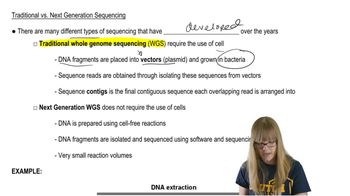In 2010, a U.S. District Judge ruled to invalidate Myriad Genetics' patents on the BRCA1 and BRCA2 genes. Judge Sweet noted that since the genes are part of the natural world, they are not patentable. Myriad Genetics also holds patents on the development of a direct-to-consumer test for the BRCA1 and BRCA2 genes.
J. Craig Venter has filed a patent application for his 'first-ever human-made life form.' This patent is designed to cover the genome of M. genitalium. Would your ruling for Venter's 'organism' be different from the judge's ruling on patenting of the BRCA1 and BRCA2 genes?
Table of contents
- 1. Introduction to Genetics51m
- 2. Mendel's Laws of Inheritance3h 37m
- 3. Extensions to Mendelian Inheritance2h 41m
- 4. Genetic Mapping and Linkage2h 28m
- 5. Genetics of Bacteria and Viruses1h 21m
- 6. Chromosomal Variation1h 48m
- 7. DNA and Chromosome Structure56m
- 8. DNA Replication1h 10m
- 9. Mitosis and Meiosis1h 34m
- 10. Transcription1h 0m
- 11. Translation58m
- 12. Gene Regulation in Prokaryotes1h 19m
- 13. Gene Regulation in Eukaryotes44m
- 14. Genetic Control of Development44m
- 15. Genomes and Genomics1h 50m
- 16. Transposable Elements47m
- 17. Mutation, Repair, and Recombination1h 6m
- 18. Molecular Genetic Tools19m
- 19. Cancer Genetics29m
- 20. Quantitative Genetics1h 26m
- 21. Population Genetics50m
- 22. Evolutionary Genetics29m
17. Mutation, Repair, and Recombination
Induced Mutations
Problem 28
Textbook Question
In an Ames test using his⁻ Salmonella bacteria a researcher determines that adding a test compound plus the S9 extract produces a large number of his⁺ revertants but mixing the strain plus the test compound without adding S9 does not produce an elevated number of his⁺ revertants.Is the test compound still considered to be a potential mutagen? Explain why or why not.
 Verified step by step guidance
Verified step by step guidance1
Understand the Ames test: The Ames test is used to determine whether a chemical compound is a mutagen, meaning it can cause mutations in DNA. It uses a strain of Salmonella bacteria that cannot synthesize histidine (his⁻) unless a mutation occurs to revert it to his⁺.
Interpret the role of the S9 extract: The S9 extract contains enzymes, typically from the liver, that mimic the metabolic processes in a living organism. Some compounds are not directly mutagenic but become mutagenic after being metabolized by these enzymes.
Analyze the results: In this experiment, the test compound alone does not produce an elevated number of his⁺ revertants, indicating it is not directly mutagenic. However, when the S9 extract is added, a large number of his⁺ revertants are observed, suggesting that the compound becomes mutagenic after metabolic activation.
Determine if the compound is a potential mutagen: Based on the results, the test compound is still considered a potential mutagen because it induces mutations after being metabolized by the enzymes in the S9 extract. This mimics how the compound might behave in a living organism.
Conclude the explanation: The Ames test results indicate that the compound is not directly mutagenic but is a potential mutagen after metabolic activation. This highlights the importance of including the S9 extract in such tests to assess the mutagenic potential of compounds that require metabolic conversion.
 Verified video answer for a similar problem:
Verified video answer for a similar problem:This video solution was recommended by our tutors as helpful for the problem above
Video duration:
5mPlay a video:
Was this helpful?
Key Concepts
Here are the essential concepts you must grasp in order to answer the question correctly.
Ames Test
The Ames test is a widely used assay to assess the mutagenic potential of chemical compounds. It utilizes strains of bacteria, typically Salmonella, that are unable to synthesize histidine (his⁻). When exposed to potential mutagens, these bacteria may revert to a his⁺ phenotype, indicating a mutation. The presence of revertants suggests that the compound can induce genetic changes, which is a key factor in evaluating mutagenicity.
Recommended video:
Guided course

Induced Mutations
S9 Extract
S9 extract is a metabolic activation system derived from the liver of rodents, containing enzymes that mimic the metabolic processes that occur in living organisms. In the Ames test, S9 is added to assess whether a compound requires metabolic activation to exert its mutagenic effects. The presence of S9 can enhance the detection of mutagens that are inactive in their original form but become reactive after metabolic conversion.
Recommended video:
Guided course

Traditional vs. Next-Gen
Mutagenicity
Mutagenicity refers to the ability of a substance to cause mutations in the DNA of organisms. A compound is considered a potential mutagen if it can induce genetic changes that may lead to cancer or other genetic disorders. In the context of the Ames test, if a compound produces a significant number of revertants in the presence of S9 but not without it, it suggests that the compound may require metabolic activation to exert its mutagenic effects, indicating its potential as a mutagen.
Recommended video:
Guided course

Induced Mutations
Related Videos
Related Practice
Textbook Question
305
views


